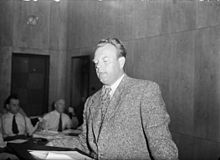Halvdan Eyvind Stokke
Halvdan Eyvind Stokke (born November 20, 1900 in Fredrikstad , † December 15, 1977 in Oslo , born Halvdan Eyvind Johannessen ) was a Norwegian politician of the Arbeiderpartiet , first mayor of Oslo after the merger with Aker from 1948 and for 15 years general director of Norges Statsbaner . He made a major contribution to the modernization and rationalization of railway operations in Norway by reducing steam operation, closing unprofitable routes and electrification.
Halvan Eyvind Stokke was the son of Kjelesmed Anton Johannessen (1857-1936) and Helen Anderson (1865-1944). He married Esther Pedersen on December 19, 1925 in Oslo. The name change to Stokke took place in 1930.
Curriculum Vitae
Stokke grew up in Fredrikstad. After graduating from middle school in 1917, he served in the Navy for a year . From 1919 to 1920 he attended the telegraph school and was one of the first to include a course in radio engineering. From 1920 Stokke was employed by Telegrafverket in Kristiania. From 1921 to 1922 he was secretary of the administrative board of the telegraph administration, from 1922 to 1924 in the technical department and from 1924 to 1926 as secretary in the department Kristiania / Oslo telefonanlegg . With the opening of the broadcasting station in Fredrikstad, Stokke became its director from 1926. From 1929 he went back to Oslo as secretary of the executive committee of the telegraph department. In 1938 he was promoted to office manager.
After Norway was liberated from German occupation, Stokke was temporarily head of the Ministry of Labor on May 8, 1945 until May 14, 1945. Stokke was the last mayor of Aker Municipality from 1946 to 1947 before the merger with Oslo. From 1947 he was the personal secretary of the Minister of Transport and from July 11, 1947 State Secretary in the Ministry of Transport . He gave up this position on January 21, 1948 when he became mayor of the new municipality of Oslo in connection with the merger of Oslo and Aker in January 1948. Aker's local politicians and residents had deep-rooted distrust of Oslo and secured his place on the city council in the 1948 local elections with a joint election recommendation. He held the post of Mayor of Oslo from 1948 to 1956.
In 1950 Stokke became General Director of Norges Statsbaner (NSB) for six years. This term of office was later extended, first by six and then by a further three years.
Stokke recognized early on that the railroad had to be modernized and made with fewer staff. In this context, he introduced the Vekk med dampen program ( German "Weg mit dem Dampf" ). The electrification of large parts of the network and the procurement of diesel locomotives for the remaining routes should make rail traffic more efficient. From 1954 several series of diesel locomotives were bought and in 1971 steam operation in Norway was history. Under the leadership of Stokke, the first unprofitable branch lines with little traffic were closed .
Political résumé
Stokke's father was politically active and one of the first to get involved in the Norsk Jern- og Metallarbeiderforbund ( German "Norwegian Iron and Metal Workers Association" ). Stokke himself was very soon active in the Telegrafmennenes Landsforbund ( German "Landesverband der Telegrafenarbeiter" ). In 1926 he became chairman and in 1951 honorary member. He was active in political youth work, first as a member of the social democratic youth ( Norwegian "Det socialdemokratiske ungdomslag" ) in Kristiania and later as a youth pioneer in Fredrikstad. In 1924 he was elected deputy chairman of the Norges Socialdemokratiske Ungdomsforbund ( German "Norwegian Social Democratic Youth Association" ). He headed the association as chairman until 1926.
Stokke was from 1928 to 1929 a member of the city council of Fredrikstad and from 1932 to 1948 local council in Aker, from 1945 the first mayor of the Arbeiderpartiet in Aker. After Aker merged with Oslo, he was mayor of the new municipality until the end of 1950. The major events of this time include the city's 900th anniversary in 1950 and the opening of the new town hall . In the same year, she signed an agreement with the landowners that has since secured the Nordmarka as a local recreation area for the capital.
HE Stokke was from 1945 to 1948 chairman of Statens samferdselsnevnd ( German "Staatlichen Verkehrsnetze" ) and from 1969 to 1971 on the board of Akers Sparebank .
Honors
- 1956 - St. Hallvard Medal
- 1960 - Commander of the Order of Saint Olav
- Royal Medal of Merit
- Commander of the Danish Dannebrogorden
- Bearer of the Swedish North Star Order
- Holder of the Finnish Finnish Order of the White Rose
Individual evidence
- ↑ DIS Gravminner i Norge. In: disnorge.no. January 1, 2009, accessed April 8, 2014 (Norwegian).
- ^ Secretaries General and Government Delegation 8-14 May 1945. In: Government.no . March 12, 2011, accessed April 8, 2014 .
- ^ Einar Gerhardsen's Second Government November 5, 1945 - November 19, 1951. In: Government.no . March 12, 2011, accessed April 8, 2014 .
- ^ Norwegian Ministry of Transport and Communications State Secretaries 1947-. In: Government.no . October 25, 2013, accessed April 9, 2014 .
Web links
- Halvdan Eyvind Stokke. In: Store norske leksikon . Retrieved April 7, 2014 (Norwegian).
- Nils Carl Aspenberg: HE Stokke. In: Norsk biografisk leksikon . Retrieved April 7, 2014 (Norwegian).
| personal data | |
|---|---|
| SURNAME | Stokke, Halvdan Eyvind |
| ALTERNATIVE NAMES | Johannessen, Halvdan Eyvind (maiden name) |
| BRIEF DESCRIPTION | Norwegian politician (Labor Party), member of the Storting and railway manager |
| DATE OF BIRTH | 20th November 1900 |
| PLACE OF BIRTH | Fredrikstad |
| DATE OF DEATH | 15th December 1977 |
| Place of death | Oslo |

